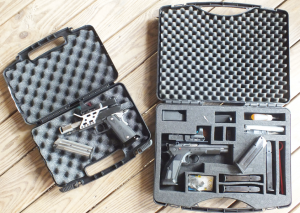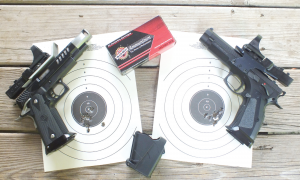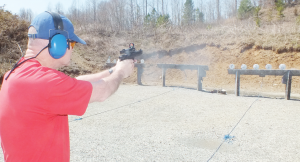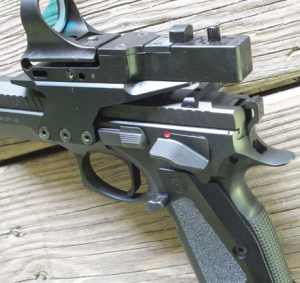by Dick Jones | Contributing Editor
Photos by Cherie Jones
Most guns come from the manufacturer fully functional for the purpose they are intended. Those purposes generally involve defense, hunting, plinking or light competition. Very few guns come from the factory in full competition trim, just as a competitive shooter would use them. Normally competition shooters perform trigger jobs, sight changes and grip modifications that make a factory gun more suitable for match competition.
A couple of years back, I used a Springfield XDm 5.25 that had been massaged a bit in the Springfield Custom Shop and it did an admirable job in Production Class in the Bianchi Cup that year. Though I’m not an action shooter, and past 60, I managed an Expert classification with that gun right out of the box. Some of the AR 15 rifles meant for CMP Excellence in Competition matches are capable of garnering Leg points though I doubt they could win many matches. These are excellent examples of factory guns that work for competition, but for every one of those guns, there are dozens of others that are totally unsuitable for competition.
At SHOT Show this year, I noticed two guns that met those criteria.
Neither of these guns was capable of winning the Bianchi Cup without modification, but both are definitely capable of winning local matches and I proved this by winning a plate match with one of them the first time I entered one. These are out of the box race guns from the manufacturer; they come ready to run complete with a C More competition reflex sight.
They are not cheap, both guns cost over $3,000, but guns like this can’t be built by an individual for less money by buying the components. Are they the ultimate solution for a competition shooter? Probably not, but for someone who wants to get a gun that can win local matches without going through the learning process of how to build a gun, they are both very good.
For this project, I chose 9mm as the caliber. In certain matches with Power Factor requirements, a standard 9mm is a minor caliber but many matches don’t require a Power Factor. I also planned to shoot the 2013 Midway USA Bianchi Cup with one of these guns and 9mm handily makes the 120,000 Power Factor for Bianchi. Economically speaking, 9mm is the most viable caliber for the beginning competitor. It’s cheap, recoil is mild, and it is easy to reload.
With one of the guns, there was a provision to load the gun heavier to allow punching up the 9mm cartridge to make Major Power Factor, though I didn’t travel down that street.
I chose the CZ Czechmate because it represented, not only a lot of value, but it was also a departure from the traditional 1911 venue that’s so popular among competition shooters.
The Czechmate is an all business gun with features only competition guns have. There is an ambidextrous safety and magazine release capability, a flat trigger, and a standard magazine capacity of 20 rounds with a 27-round magazine available. The Czechmate also has a non-1911 grip and offers a departure from that familiar grip angle for those who don’t like it. It is a heavy gun at 51 ounces compared to the STI Steel Master at 46 ounces but, in some forms of competition, weight can be a positive thing.
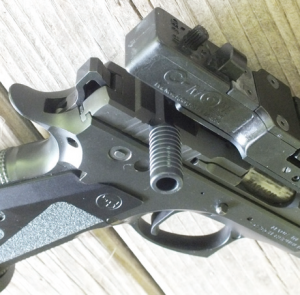
The charging handle that fits in the rear sight slot eliminates the problem of charging a scoped pistol
The STI name is synonymous with high quality 1911 platform pistols and the Steel Master is certainly eligible for that reputation. Based on the 2011 style double stack frame, the Steel Master is lighter than the Czechmate and not designed for shooting 9mm rounds that are hopped up to make Major Power Factor. The recoil spring is remarkably light, and with a standard magazine capacity of 17 rounds, with 20- and 26-round magazines available, the STI is capable of a lot of shots when the match allows for extended strings with no mandatory magazine changes. It comes with the same C More sight furnished with the Czechmate.
I received the Steel Master first and decided to take it to the monthly plate match at Piedmont Handgunner’s Association (PHA). I am not an action pistol shooter, though I have competed in some matches. From the standpoint of covering an event, there is no better observation point than just in front of a competitor number so I’ve shot the Bianchi three times. One part of the Bianchi that always gives me trouble is the Falling Plate Event. For me, it seems to be the Non-Falling Plate Event because something about plates has an adverse effect on my performance. Shot at ranges from 10 to 25 yards in five-yard distances, the plate course of fire allows the shooter six seconds for six plates at 10 yards and adds another second to the time every time you move back another five yards. PHA shoots a double plate match so a perfect score is a 96. My personal best had been a 71, though I’d only shot the match four times.
I zeroed in the C More on the Steel Master, adjusted a friend’s Safariland open holster to fit it, and went to the match. On the first 48 plates, I shot a 45, on the second, I repeated the performance. I won the match and shot my personal best with a gun I’d only had possession of for a week.
The Steel Master is light and fast, as a gun designed for the fast acquisition and neutralization of targets should be. The safety is ambidextrous and the gun feels thin for a double stack. I think part of this is the weight and part is the contour of the polymer grip. In order to get a thinner double stack grip, STI built their 2011 series of guns with a two-piece frame. The part of the frame that holds the action of the gun is steel, but the grip portion is polymer and comes in several
different colors.
Since the Steel Master is not designed to meet power factors, it is tuned with a very light spring, almost as light as a rimfire conversion spring. This gives the gun a racy feel and contributes to the apparent purpose of getting accurate rounds off quickly. I normally have trouble with time on plate matches yet I didn’t have a single late shot with the Steel Master. Just this alone illustrates the difference between shooting a serious competition gun and an out-of-the-box pistol. True, this is an open class gun and the guns I shot before were production guns, but the difference is remarkable.
Having said all this, even guns of this level can still have problems. The STI came to me as a writer’s sample and so, there was some potential for things to have issues. The trigger, while very good, had just an edge of creep and the magazine wouldn’t drop. It turned out that someone had monkeyed with the trigger and the trigger stirrup was dragging the magazine, having an effect on both issues. The fix was simple, but the issue illustrates that there is always a potential for a problem, even with the best guns.
I also had an issue with the Czechmate that related to my style of holding the gun. I didn’t notice it until I began shooting the barricade on my range to get a better handle on the Barricade Event in the Bianchi. I later noticed it when shooting prone and practicing for the Practical, an event that requires shooting from 50 yards, where going prone makes sense even if you’re past 60 and getting up isn’t as easy as it once was.
The problem was that the meat of my right index finger apparently was pushing the safety up on the right side of the gun. I also found the standard safety a little harder to disengage than a 1911-style safety.
CZ’s Custom Shop resolved the problem by removing the right side safety and installing an oversized left side safety. This fixed the problem but I still had occasional issues with the slight difference in the distance the trigger moves to reset. It was only a small distance, but somehow, I managed to sometimes miss allowing the trigger to reset before beginning the next pull.
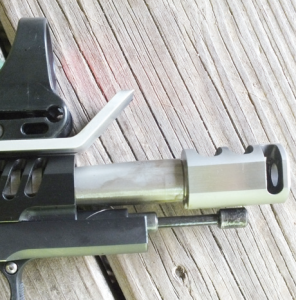
STI Steel Master fitted with a muzzle brake. The aluminum blast shield protects the lens of the C-More sight
Both guns have excellent triggers, though neither is absolutely perfect as I’ve felt when handling the guns of Bruce Piatt and Carl Bernosky. Both guns are dead reliable; I fired a lot of rounds through both and didn’t experience a single malfunction other than my method of gripping the gun, causing the safety to re-engage on the Czechmate. In accuracy testing, the Czechmate had a slight accuracy edge on the STI but the difference was so slight as to be a non-issue. Different ammunition might have pushed the advantage to the STI.
Choices like this come down to the personal preferences of the buyer. I could fully recommend both guns to anyone who wants to get into an open gun without the process and time required to build one from scratch.
For the beginning competitor, the subtle preferences that go into championship guns are based more on personal preference than on an actual advantage of one gun over another.
The STI has a racier faster feel than the CZ. At mid grip, the CZ is .070 thinner than the STI but the STI feels slimmer. It feels very compact and integrated and would naturally appeal to the follower of 1911s.
The CZ feels solid and is noticeably heavier. In spite of the fact it’s sold to allow shooting Major 9mm, it will handle the softest loads I tried without malfunction. While both guns have almost the same retail price, the CZ represents a better value when you consider what comes with it. The STI comes with just one magazine. The CZ comes in a suitcase-sized case with one 27-round magazine and three 20- round magazines. It also comes with a muzzle brake designed for shooting Major 9mm and an extra barrel, a small tool kit, extra magazine release and a magazine loader. This represents a considerable amount of value.
I had four competitive shooters shoot both guns and all agreed the choice would come down to personal preference and none would say which of these two excellent guns was superior. The extra magazines in the CZ case actually sealed the deal for the gun I used in the Bianchi Cup. All this happened in the crazy days following the Sandy Hook murders and my extra STI magazines were still on back order just a couple of weeks before I had to leave for Columbia. Since I had four magazines to fit the CZ, it made the trip to Missouri. The Czechmate did a great job but I know the STI Steel Master would also have served me well. I only wish I had the skill to exploit the capability of these two fine pistols.